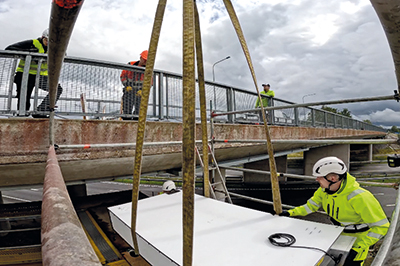Muon tomography: how natural radiation could replace X-rays in bridge inspections
04/11/2025
Scientists at the Federal Institute for Materials Research and Testing (BAM) want to lay the foundations for the use of muon tomography in the realm of infrastructure. The technology uses particles that occur when cosmic rays enter the Earth’s atmosphere. The intention is to use this method for inspections and assessments that could previously only be carried out using X-ray technology.X-rays are rarely used anymore for inspecting buildings due to radiation protection regulations. However, there is no adequate substitute for a method that allows a view into the interior of concrete. Muon tomography could provide a solution, as it uses part of Earth’s natural radiation and is therefore harmless. Muons are created when cosmic rays enter the Earth’s atmosphere, react with air molecules and are then broken down.
 | ||
| Installation of GScan’s XL scanners at the Mäo bridge in Estonia |
“Extensive research into muon tomography in construction has not yet been carried out. The technology is still in its infancy,” said Dr Ernst Niederleithinger, Head of the Non-Destructive Testing Methods for Construction department at BAM. “Our experiment aims to contribute to placing the use of muon scanners on an even more solid scientific footing and possibly promote the introduction of the method in this country. Accuracy and resolution would be sufficient for most inspection purposes in the infrastructure sector.”
In a joint experiment with the start-up GScan, BAM researchers compared the results of measurements taken with radar, ultrasound and muon tomography. This involved measuring a concrete test beam developed at BAM for reference experiments. The muon scanners were supplied by GScan. The company has validated prototypes in collaboration with the British National Highways and measured bridges in Estonia. For the experiment, two scanners were placed above and below the test beam, which, with a thickness of 50 cm, is comparable to many bridge structures. It is also much bigger than any previous objects used to test the GScan detectors. To provide a realistic scenario, the test beam contained a casing with tension wires, as stress corrosion cracking is a typical problem in bridges. Half of the beam was fitted with a reinforcement grid and also contained several Styrofoam balls of different sizes to simulate cavities.
The results show that muon tomography provided more information than the other two methods. While all three technologies (ultrasound, radar and muons) detected the reinforcement grid, the casing and some of the polystyrene balls, muon imaging revealed the most objects. It was the only method that was able to determine approximately correct measurements and also allow 3D imaging. The position and size of the objects are calculated by the scanners based on the changed flight paths of the muons. Due to their high energy density, they are able to penetrate large objects but are deflected when they encounter obstacles. The measurement data is first processed directly in the scanner and then assembled into a 3D image in the cloud using a machine learning model.
The technology has the potential to detect compaction errors in casing pipes or even corrosion damage inside the pipes. However, measurements using muon tomography take a very long time and this experiment took two weeks. On the other hand, the method is suitable for particularly large structures. In the past, it has been used to survey volcanoes, Egyptian pyramids and one of the reactors in Fukushima.
www.bam.de